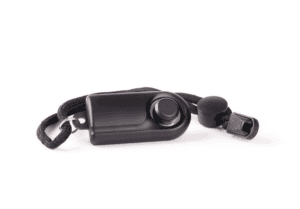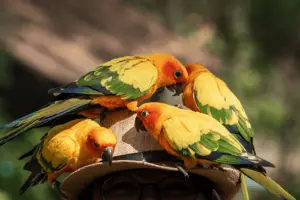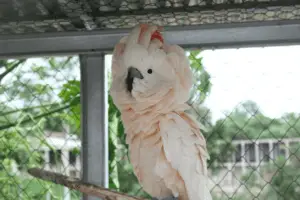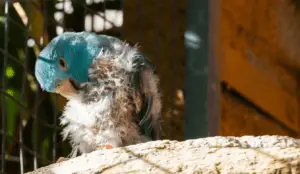Have you been wondering if you should clip or not clip your parrot’s wings? Or do you know that you have that option? Well, you’ve come to the right place. Clipping has several benefits and cons, but most people are still on the fence about this issue. After all, our birds naturally shed their feathers every season, but should we help by clipping their feathers?
Clipping some of your parrot’s primary feathers can prevent it from flying away. Still, it is being discouraged by avian vets worldwide. After all, it can result in injuries when they try to get off the ground or into their cages.
Wing clipping is one of the most controversial topics among avian lovers. Sure, it can keep your bird grounded but has many other negative impacts. So in this article, we’ll elaborate more on clipping and its pros and cons. We’ll also show you how to do it correctly if you have to. On top of that, we’ll give alternative solutions to preventing your bird from flying all over the house.
What Is Wing Clipping?
Generally, there are many ways to prevent your parrot from flying all over the aviary. And one of the most common but discouraged ones is wing clipping. After all, wing clipping is not the same thing as cutting hair or nails. Hair and nails can regrow within a few days, while the wings can take a few months.
On top of that, we can do without the nails and hair, but our birds need their primary wing feathers to survive in the wild and in captivity. They need their feathers to fly away in a home with dogs and cats, which can attack them when they’re on the ground or outside their cages.
Clipping of the wings refers to trimming of the remiges or primary wing feathers so that our birds are not fully flight-capable. The feathers will regrow once they molt and shed the cut feathers creating space for new ones to grow. Clipping is a straightforward process that can be done by bird owners, breeders, pet store employees, and vets.
Wing clipping is not the same thing as pinioning, and it can be harmless and painless if done correctly. Pinioning refers to a process that hinders the growth of your bird’s primary feathers while preventing acceleration while flying. Unfortunately, most breeders advise against clipping a parrot’s primary wings; in fact, they encourage the birds to fly around as soon as they can.
Pros
- Wing clipping limits your parrot’s horizontal and vertical flight: clipping the parrot’s wing feathers makes it impossible for your new parrot to escape through a window or door. And if your parrot manages to escape, it won’t get far, thanks to clipped wings. But there are other ways to prevent your bird from flying away, like the Avian Flight Suit. An Avian Flight Suit can prevent your bird from flying when outside its cage.
- Wing clipping can make it easier to hand train a bird: with little to no flight capabilities, you can easily handle the bird outside the cage. After all, they will spend a huge percentage of their time on the perch, which means you can easily train it without worrying about the bird flying all over the room. Sometimes our pets can be quite stubborn and sassy, so clipping their wings can help you grab them when they try flying away.
- Ceiling fans are a huge hazard for parrots when outside the cage: limited flight capability lowers the likelihood of decreasing the likelihood of the bird flying into the fan.
Cons
- Dogs and cats can become a threat to a bird with clipped wings: generally, flight helps our birds escape predators when in the wild and in captivity. So if you have cats and dogs in your home, then clipping the wing feathers might not be a good idea. Clipping the feathers will leave your parrot vulnerable to other pets in the house.
- Parrots with some clipped wings stay in lower areas which will make it difficult for you to see them: since they will always be on the floor, you might end up stepping on them, so clipping the feathers leaves your pet exposed to injuries.
- Clipping will introduce a feather-picking problem: birds with clipped feathers generally tend to pick their other feathers more than the unclipped ones. So you might end up with bad behavior that will be hard to eliminate.
How to Clip the Parrot’s Wings
As mentioned, clipping or not a parrot’s wings is controversial among avian lovers. It might stop your bird from flying away, but it does expose it to many dangers, including being stepped on and the other pets in your home.
If you don’t have other pets in the house and are looking for a way to control your pet, then you should try clipping. But make sure you do it correctly and make the process as painless as possible. If you have never clipped the parrot’s winds, then you should do the following:
- Prepare to Clip the Wings
Before you start the process, you should ensure that you have styptic powder, a pair of scissors, a towel, and an assistant. The styptic powder can come in handy if you end up cutting too much and leave your pet bleeding. If you’re doing it for the first time, then you should get assistance to help you out.
- Use The Towel
Start by draping the towel over your hands and stay relaxed while facing your pet. And then gently wrap it over the bird if possible, but if it’s not possible, then you can work without one. If you’re working without a towel, you can start by placing your index finger on its head while holding the sides of its lower mouth with your other fingers.
Doing this will prevent the parrot from biting you or your assistant. If you’re using a towel, you can make sure you secure the feet inside the towel. The towel will prevent the bird from scratching you, but make sure the bird doesn’t get stressed when restrained.
- Determine the Feathers to Clip
Remove the wings from the towel restraint and determine which feathers to clip. The primary flight feathers are the longest ones or the last ten feathers. You can talk to the vet before cutting the feathers and find out which ones you should be cutting.
- Cut off the Feathers Using a Pair of Scissors
Make sure you leave a few centimeters between the small feathers and the cut ends of the primary feathers. You might be tempted not to clip the two outer feathers alone for appearance’s sake, but we advise you against it.
- Avoid Clipping the Pin or Blood Feathers
Pin feathers are the new ones that have just started growing out. They’re endowed with waxy sheath and some veins supplying blood to them. You can view the blood inside the feather tube. But if you accidentally cut one of them, you shouldn’t worry too much since it will clot. If you end up injuring one for the second time, then you should have a styptic powder in handy. (3)
Should I Clip or Not Clip the Wing Feathers of My Parrot?
Well, the answer to this question varies with the pet owner. Sure, clipping the primary feathers can come in handy when it comes to preventing it from flying away. And you may do everything possible to keep it safe after clipping its feathers. But do you know that they need the feathers to do more than fly?
Well, clipping its feathers will prevent it from working out, which most essential than the need to avoid predators. This leaves them stressed since they can’t protect themselves, resulting in some of them transferring this pain to feather plucking, screaming, biting, and even self-mutilation.
Since they can’t fly around, some parrots can become tethered to the cage or always defend themselves. They’ll attack anyone who invades their space. So clipping their wing feathers will leave you with more problems to deal with, which can be avoided by a simple thing such as an avian flight suit or proper training.
Can You Clip the Wing Feathers of Baby Parrots?
No, the feathers of baby parrots should never be clipped; after all, they’re not flying around yet. Plus clipping their feathers at a young age can stunt the normal growth rate of their feathers, which can become an issue when they grow up.
Conclusion
Feather clipping is common practice among bird owners, especially when dealing with a new pet. After all, it can keep your pet grounded and make it impossible for it to fly away when outside the cage. While this might work, we advise against it since it will leave your pet vulnerable to other dangers in your home, including yourself.
Plus, it can leave your pet stressed and plucking its other feathers. But if you have to do it, you should do it properly. And make sure it’s as painless as possible. To be on the safe side, you can keep the styptic powder near you and even work with a partner.
- Wikipedia contributors, Wing Clipping, https://en.wikipedia.org/wiki/Wing_clipping/ Accessed May 17, 2023
- Wikipedia contributor, Pinioning, https://en.wikipedia.org/wiki/Pinioning/ Accessed May 17, 2023
- Pippa Elliot, How to clip a Parrot’s Wings? https://www.wikihow.com/Clip-a-Parrot%27s-Wings/ Accessed May 17, 2023










